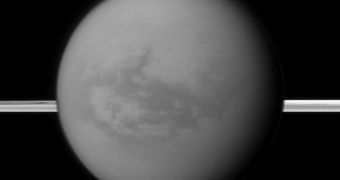NASA Jet Propulsion Laboratory (JPL) experts announce the discovery of a fairly large, long-standing lake in the tropical regions of Saturn's largest moon, Titan. The discovery is puzzling because experts had previously thought that liquid hydrocarbons were only confined to the celestial body's poles.
For this study, experts used the NASA Cassini spacecraft, which has been studying the gas giant, its rings and its moon system since July 1, 2004. The satellite was able to image a massive lake at Titan's tropics, which is apparently two times smaller than the Great Salt Lake, in Utah.
A rough analysis of the Cassini data appears to indicate that the lake is at least 1 meter (3 feet) deep, possibly more. Rather than being filled with water, its main constituent is the hydrocarbon methane.
There are significant similarities between Earth and Titan, space scientists say, especially in terms of how their atmospheres operate. The main difference is that Titan does not use water as a basis for its process, but rather liquid hydrocarbons such as methane or ethane.
Surface temperatures on the large moon average −179.5°C (93.7 Kelvin, -291°F), which means that ice there is tougher than granite on Earth. Investigators publish details of their new discovery in the latest issue of the top scientific journal Nature.
The conclusions of the research are very puzzling for astronomers, since computer models they've developed thus far to explain Titan's behaviors hold that methane lakes cannot form at other locations except the pole. Observations conducted thus far have confirmed the models over and over again.
The issue now is explaining where the hydrocarbons are coming from. Given the similarities between Titan and our plant, experts believe that we may look here for answers. “A likely supplier is an underground aquifer,” investigator Caitlin Griffith says.
“In essence, Titan may have oases,” she goes on to say. Griffith was the lead author of the Nature paper, and holds an appointment as a Cassini team associate at the University of Arizona in Tucson.
“An aquifer could explain one of the puzzling questions about the existence of methane, which is continually depleted. Methane is a progenitor of Titan's organic chemistry, which likely produces interesting molecules like amino acids, the building blocks of life,” the UAT expert adds.
The emerging view now is that Titan is significantly more complex that first thought. Scientists say that there's more to the moon than dunes at the equator and methane lakes at the poles.

 14 DAY TRIAL //
14 DAY TRIAL //